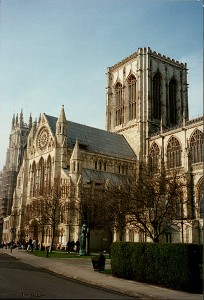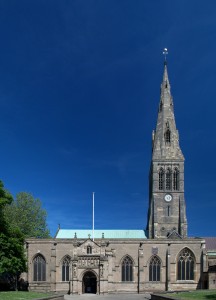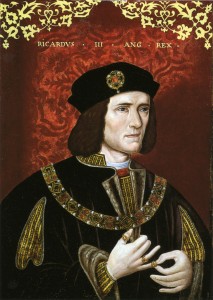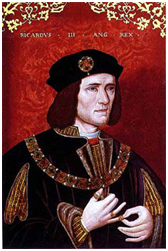KRA-Week 2013-5: Fitzg – Sumptuary Laws
Links: King Richard Week 2013 & Quiz
♕ ♛ ♕
SUMPTUARY
Sumptuary laws
in Medieval and late medieval England.
(by Fitzg)
“Laws made for the purpose of restraining luxury or extravagance, particularly against inordinate expenditure in the matter of apparel, food, furniture etc.”
Black’s Law Dictionary.
English Sumptuary Laws date from 1281 in extant documents. They were then an expression of the Feudal System (every man in his place, dressed according his station. Women too.) The hierarchy must be established according to the “natural law”.
The next documented Law is that of 1309. This relates to conspicuous food consumptions of the nobles. (Peacocks presented at table, complete with feathers re-attached to the roasted fowl…)
Perhaps Edward III felt that such expenditure by his magnates reduced their monetary contributions to his Scottish and overseas wars.
Obviously, Kings and their families were not restricted by such fiscal management restraints.

cloth of gold – Richard III earliest known copy of original; dated early 16th century (Source: Society of Antiquaries, London – Wikipedia)
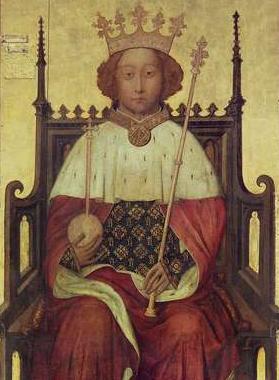
Richard II, c. 1390s. (Source: Westminster Abbey – Wikipedia)

Wilton Diptych (Source: National Portrait Gallery, London – Wikipedia)
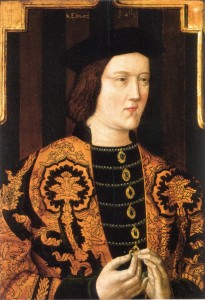
Edward IV. Portrait early 16th century (Source: Society of Antiquaries – Wikipedia)

Henry VII, c. 1505 (Source: National Portrait Gallery, London – Wikipedia)
Cloth of gold, fur, gold…. It appears that the first Tudor, despite a somewhat austere, penny-pinching reputation, at least in the popular version, was not averse to personal display.
However, there was considerable Church disapproval of courtly display of fashion “trends“. Shoes, in 15th C, were an issue with the Church: the vanity of the elongated toes.
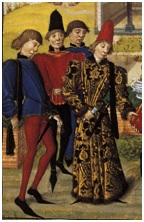 |
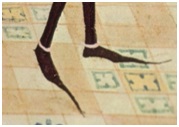 |
 |
And then, there was the Disney head dress. The Henin, and variations thereof.

Hans Memling, Lady Donne of Kidwelly. The Donne Triptych, c. 1478 (Source: Wikipedia)
The middle class was rising in wealth, and becoming uppity in dress. Note the quantities of costly material in the sleeves and gowns and richness of dyes.

Hans Fouquet, the Melun Dipptych, c. 1452 (Source: Wikipedia)
Etienne Chevalier, was not a merchant, but a trusted civil servant.
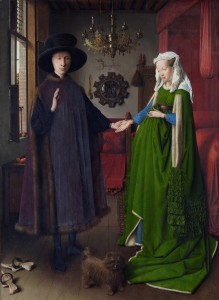
The Arnolfini Wedding, Jan van Eyck, c. 1434 – Italian merchant and his wife (Source: National Portrait Gallery, London – Wikipedia)
Disconcertingly to the “enforcers” of the Sumptuary Laws, the merchant class rose inexorably. The merchant class accumulated wealth, based on wool and textiles, and import/export. They bought off the enforcers’ fines, and even lent funds to cash-strapped nobility. They were going to wear what they had earned. Their wives (and often mercantile partners/supporters) were an advertisement to their wealth and their often mutual hard work. (Take that, Enforcers! 😀 )
England has not been quite as rigidly class-ridden as might be thought – upward mobility was mobilised. From 15th century sheep farmers, the Churchills were Dukes of Marlborough two centuries later. A middle class was firmly rising throughout Europe, driven by trade – wool/textiles/luxury goods from the East. The sheep farmers became merchants (and money-lenders), married into gentry and titled families, became senior civil servants.
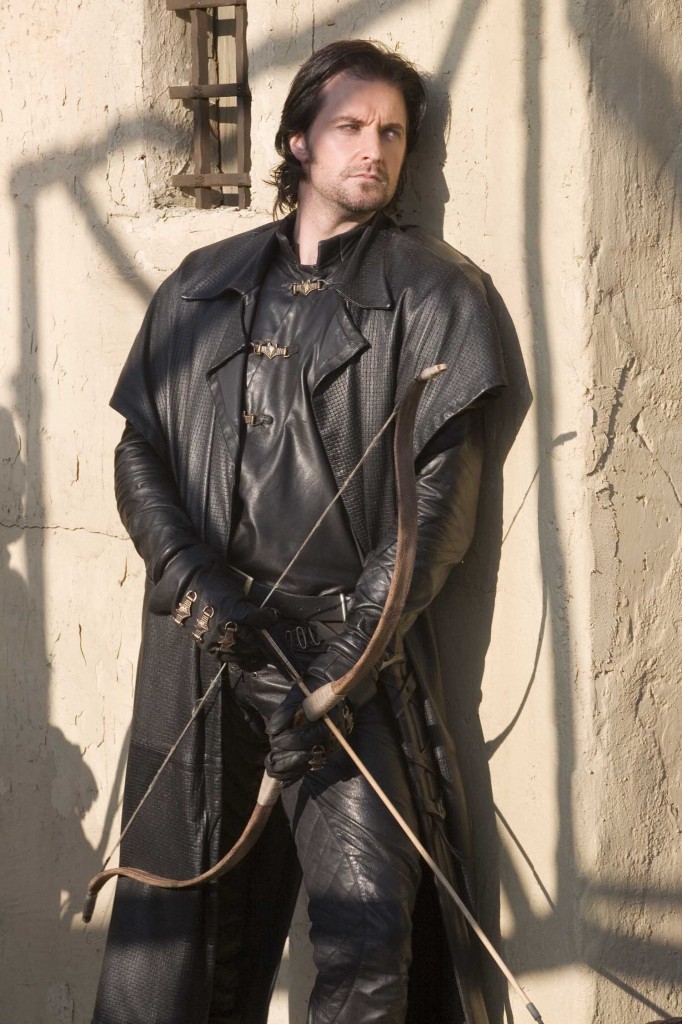
BBC “Robin Hood” Guy of Gisborne (Source: RichardArmitageNet.com)
Sir Guy of Gisborne, dressed head to toe in costly leather. Would a minor knight, in possession of an obscure provincial manor, pass the Sumptuary laws? Leather tanning and production were extremely costly, as is the case today. Perhaps; it didn’t involve cloth of gold or furs….
And Many Happy Returns to Richard Armitage on August 22 2013.
Respects to King Richard III, may he please be laid to rest as befits an anointed monarch.
SOURCES (for the costume-obsessed)
- www.medieval-life-and-times.info-medieval-clothing/medieval-sumptuary-laws.htm
- www.medieval-castle-siege-weapons.com/medieval-clothing.htm
- www.batashoemuseum.ca/collections/permanent/history_western_fashions/medieval/index.hstml
- Boucher, Francois. 20,000 Years of Fashion; Henry H. Abrams Inc. New York.
Links: King Richard Week 2013 & Quiz
Fitzg: End the Wars of the Roses – NOW

Richard III – Head Reconstruction (Source: Richard III Society)
By no right (Divine or otherwise) conferred upon me, I hereby decree that the remains of the late (late by 500+ years, for his own funeral) much maligned King, Richard Plantagenet III of that name, be interred with due honour and respect here:
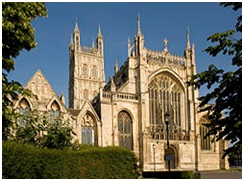
Gloucester Cathedral
Let us put an end to the unseemly media and public rowing over the re-interment of the remains of a once-anointed King. Let us take the attention temporarily from Leicester and York, and provide a public/media focus elsewhere, for a temporary hiatus, while the Esteemed Authorities resolve the issue of the primary subjects. (We can wrangle over Gloucester, instead.)
A nos moutons! What has Gloucester Cathedral to offer in place of either of the other two?
It is bigger than the formerly (until 1927) parish church of Leicester. It appears that size counts, in this issue. Tomb or floor slab?
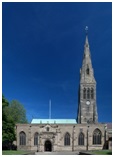
And it is prettier than Leicester…
Noble burials
Suitable tombs
Gloucester contains the alabaster tomb/effigy of Edward II.
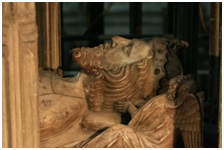
The Richard III Society commissioned and funded a design for a suitable, aesthetic RIII tomb. Apparently under dispute? by Leicester Cathedral. No room in the inn?
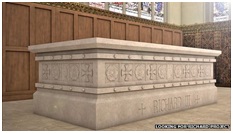
Richard III Tomb design (Source: Richard III Society)
Accomodation
Gloucester appears to be sufficiently large to accommodate a TOMB, not a floor slab, to be trodden underfoot…. (rather a slobby solution, do you think?)
Titles:
The main title of Richard III, before he took the crown, was DUKE of GLOUCESTER.
Contra?
Beyond his title, what affiliation has Gloucestershire to Richard III, of the House of York?
A quick aside about York

York Minster. As glorious a façade as that of Rouen.
The Chapter of York Minster published a statement on February 7 2013, which included the words: “…it commends Richard to Leicester’s care.” Richard, not King Richard III. They have a commemorative stained glass, in the king’s honour. Well, better than a floor slob…
And while we await the decision of Eminent Authorities to award the laurels to Leicester (with a floor slob), we can also argue about the merits of the king’s birthplace, Fotheringhay, bloodily redolent, of memories of Mary Stuart. Or Middleham, which could include coach tours to Haworth for pilgrims of varying stripes…
Please allow me to mention that this is not a serious post. It is strictly “tongue-in-cheek”, as an indirect comment on the media, etc. “wars”.
A Dwarf of our acquaintance, originally from Leicester, is wisely silent on the Wars. Obviously, he has quite enough to deal with, in retrieving Erebor for his family.

Thorin Oakenshield – The Hobbit (Source: RichardArmitageNet.com)
Richardarmitagenet Gallery. The Hobbit.
Guestpost by:
Fitzg
[Image Sources: As far as not otherwise mentioned, the images are Wikimedia Commons files.]
Portraits of a King
♛ Portraits of a King ♛
by Fitzg


There are more than twenty portraits acknowledged to depict the last Plantagenet king of England.
These two are particularly of interest, as they are identified as mid- late sixteenth century copies of lost fifteenth century originals.
The dating of paintings is both science and art, incorporating history, details of costume, era, characteristics of brush strokes – and forensics, radio-carbon and dendrochronology dating. There is much in common with the identification of the Greyfriars, Leicester skeleton. In fact, it is tempting to surmise that the identification of bones is more exact than the identification of and dating of paint on canvas or wood panels. For one thing, DNA analysis doesn’t pertain to paint/wood/canvas. For another dendrochronolgy + radio-carbon dating are not necessarily exact.

Richard III – Broken Sword portrait (Source: Society of Antiquaries of London)
This has been dated to anywhere between 1518 and 1550. 1550 is favoured by some, as it was the time of publication of the “Sainted More’s” description of the hunchback with the withered arm. (Thomas More; 14 -15 , martyred by Henry (Tudor) VIII. More’s History of Richard III was influential in Shakespeare’s Richard III.) A broken sword can be interpreted as symbolic of failure; in a regal portrait, as symbolic of prematurely ended reign by violence, battle, deposition and usurpation. Note the narrow eyes, thin lips, deformed hand and somewhat clenched jaw. Obviously, not a trustworthy man….Richard III was an excellent target for Tudor propaganda reducing the usurped line of the Plantagenets to tyrants and debauches.

NPG 148; King Richard III by Unknown artist (Source: National Portrait Gallery)
This is my favourite portrait, as it was the inspiration for Josephine Tey’s detective in The Daughter of Time. As a result of Tey’s book, I was an ardent Ricardian for many years. Dendrochronology dates the work to c. 1590. Note the higher right shoulder suggesting some form of deformity in a portrait purportedly of the late Tudor era. (This format does not allow for graphically designing blood dripping from the highlighted name of Tudor….)
“There’s no art to find the mind’s construction in the face”.
Malcolm, act 1, scene IV MacBeth.
Perhaps not. Yet we will all react to immediate expressions in others as indications of their emotions in the moment. We will even designate a face in repose as “pleasant” or “shifty” or “mean”, or “benevolent” etc.
One of the contemporary (and considered to be most objective) descriptions of Richard III is that of “an itinerant knight from Silesia”. Niklas von Poppolau provided the following in his 1484 travel diary: “…a high-born prince, three fingers taller than I, but a bit slimmer and not as thickset as I am, and much more lightly-built; he has slender shoulders and thighs.” As with other contemporary descriptions, there is no reference to hunched back or withered arm.
Characters in The Daughter of Time react to the NPG portrait in sympathetic ways (to support the author’s thesis) to the question of the detective: what do you think of this face?
The Midget: “Liver.” A succinct nurse’s opinion.
The Surgeon: “Poliomyelitis.”
The Matron: “…the most desperately unhappy face that I have ever encountered…”
As to stature, the king was generally described as “small”. Professor Jo Appleby of the Leicester University team deduced from bone measurements that, without scoliosis, Richard III would have stood 5’8” (1.72m). The average male height today in North America is 5’8” – 5’10”. The degree of scoliosis reduced a man of good height to 1.61m. Definitely short with the spinal curvature.
As the king was continually described (as prince and king) as a great battle fighter, despite the slender build, also noted by Prof. Appleby, Richard III must have built up muscle, despite the pain of the pain of the disability. (A 15th century sword weighs between five and eight pounds. And both strength and balance must be adapted to the disability. Apparently, Usain Bolt also suffers from scoliosis.)
 NPG 148; King Richard III by Unknown artist (Source: National Portrait Gallery) |
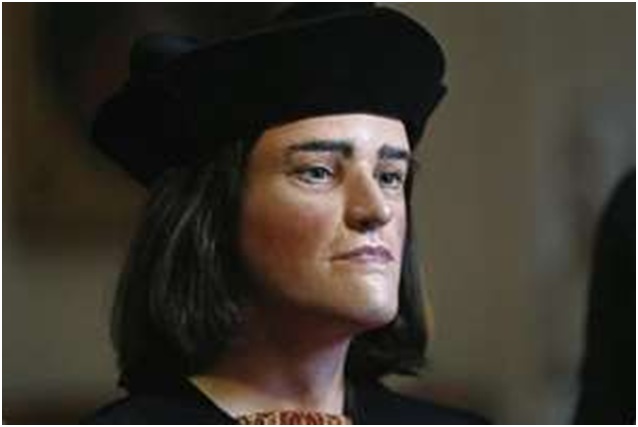 Richard III; skull reconstruction: Caroline |
Note the high cheekbones, prominent chin and not dissimilar set of the eyes and brows in these depictions. The nose of the portrait Richard is longer, with a shorter upper lip.
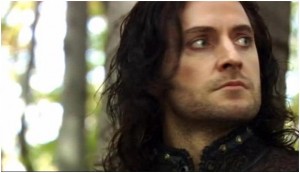
Richard Armitage (Robin Hood s3) – (Source: RANet.com)
The actor is clearly not a clone of either the portrait or of the reconstructed face. However, there is sufficient resemblance in the high cheekbones, prominent nose and delicately formed mouth for a convincing performance of the king. And many hope for the successful backing and funding for such a production to become a reality.
The perpetrator of this article descended down several rabbit holes in the process. I was sidetracked by:
- Fingerprint authentication of masterpieces;
- Dendrochronology – tree-ring dating….
- Questions pertaining to the effects of scoliosis, and the little information so far detailed by the Leicester project scientists…. more please!
- Niklas von Poppolau, “itinerant knight” from Silesia; invited to the court of Richard III; who was this man??? How did a foreign mere knight scrounge such an invitation???
It was sometimes difficult to remember what I thought was the focus of the article….but it was useful background.
SOURCES and REFERENCES
- Richard III: His Appearance; Carolyn Hammond, Richard III Society
http://www.richardiii.net.2_4_0_iii_appearance.php - Good King Richard? Jeremy Potter, 1983, reprinted by the Richard III Society
http://www.r3.org/bookcase/moremyth/html - Richard III: a study in medical misrepresentation. Isabel Tulloch for the Journal of the Royal Society of Medicine, Aug. 2009
http://jrsm.rsmjournals.com/content/102/8/315.full - Wikipedia – for general fact- and date-checking.
- Josephine Tey, The Daughter of Time; first published 1951 for some quotations.
This article was created by guest-blogger Fitzg !
– RIII-articles from the year 2012 – complete list of the year 2011 –
To Bury a King
It is getting ahead of ourselves – ahead of MtDNA testing. If these are the remains of Richard III. But the question has been raised about the final resting place of this – last of the Plantagenets. (Those most closely involved with the research, advocates of an archaeological project, forensics, genealogy and DNA experts, have been wisely circumspect about the issue.) Still, it is a wee bit an elephant in the room. Just in case it proves to be Richard III. The Palace has also been rather dispassionate with remarks about the issue. Perhaps wisely so. Some might enjoy postulating that the Windsor dynasty could be deemed usurpers. Which would be digging up a whole other can of “bones”.
I don’t think so. Genealogical tracking is a tangled web of relationships. And one dynasty succeeds another. William the Bastard was an invader. The right to the throne between Stephen and Mathilda led to civil war. Henry IV usurped the throne in 1399. Edward IV prevailed and Richard III was also a usurper in the 15th century. Then there were the Tudors… Only, it appears that the Palace is not putting out a welcome mat for Richard III at Westminster or Windsor. Oh well.
It appears that if this is our Richard, both York and Leicester might be more than willing to receive the bones, and presumably, to hold a proper (even if not in the faith of the pre-Reformation monarch) and respectful ceremony of re-internment.
It is easy to be a fence-sitter about this. York Minster is a glorious cathedral. It is very big. It has the most wonderful architecture of the medieval period. Built to endure. Except, of course, for those medieval monasteries which a Tudor king dissolved. While supporting the conversion of the cathedrals to a religious evolution. So, Leicester or York? I’m a fence sitter.
Richard converted York to the Yorkist cause. Middleham Castle in Yorkshire was reportedly, his favourite home, in which he spent his boyhood. The City of York recalls him with a fondness, not found in the South. And York is a beautiful city, retaining so much of its medieval structure.
Leicester Cathedral is the fourth smallest cathedral in England. Without the spire, it appears an ordinary town church. (But there are those pointed Gothic arched windows…) Richard was not actually born in the North, but at Fotheringhay in Northamptonshire, in the East Midlands, just a bit south of Leicestershire. Richard fought his last battle in Leicestershire, and died there.
The University of Leicester has been the linchpin of the project. Its multi-disciplinary resources have been devoted to dig process. There is rather a pleasing aspect to a small cathedral having the responsibility of a properly and well-constructed tomb and internment service, final place for a king who was not necessarily given due respect 500 years, or since.
The only contemporary indication we have of what might have been Richard III’s intent, is documentation that he intended a chapel to be built at York, for himself and Anne Neville. Anne is buried in Westminster.
So, I am a fence-sitter, and we don’t know yet the DNA results, anyway.
fitzg
♕ Poll ♕
Where do your favours lie in this discussion?
Please let us know in the poll and
vote for your favourite resting place for King Richard III
The King: Is it or isn’t it Richard Plantagenet?
The news this week has been exciting. (Understatement)
First, congratulations to University of Leicester multi-discipline crew who have performed such detailed research over a number of years to reach this point! The few publicly available clips of a press conference Sept. 12, indicate that the crew can barely contain their excitement. While measuring their words, as all professional scientists and historians must do. (I have been bouncing on My couch (NOT Oprah’s) while reading the media reports.)
However, it seems that the choir area of the Greyfriars church has not only been identified from artifacts found, but yes, human male remains were discovered. (Burial in the choir area indicates the presence of a high-born personage.) Further visual indications strongly suggest a violent death. The skull has a cleavage, consistent with having been subjected to a battle weapon. An arrowhead has been found in the rib area. Again, this is consistent with a contemporary account of the king’s death at Bosworth.
An interesting find is that the skeleton appears to indicate scoliosis, a spinal curvature, again consistent with descriptions of Richard III. But far from the Tudor/Shakespeare description of a hunch-backed cripple with a withered arm. Difficult to imagine a one-armed, crippled hunch-back as the battle-hardened warrior also described in contemporary and near-contemporary accounts. If these proves to be the remains of Richard III, it is amazing to imagine the strength of mind and spirit required to build the strength and skill, in the face of the pain and difficulty of managing a severe spinal problem.
For me, an additional personal interest (apart from having been deeply interested in this king and his times for decades), are some Canadian connections. The MtDNA is belongs to a British lady who moved to Canada following WWII. Her DNA sample, following a genealogical trace some years ago, indicates her descent from Richard’s maternal family. Dr. Turi King, of the University of Leicester forensic team, is Canadian. Small details, but adding to the personal excitement. The Canadian media has already posted accounts to date of this project.
Now, a wait for the MtDNA results. Even if a match does not prove true, or indecisive, the dig will have provided a light into 14th C history. At the least, the probability that this Richard III is high. Remember, the truth of the deaths of his nephews remains unknown, and unproven. Despite disputed origin of bones found at the Tower.
A wonderful aspect has been the convergence of history experts, archaeologists, forensic scientists, a university, and Philippa Langley of the Richard III Society, to push this project to this point. And to have been rewarded (understatement) by the current results. And congratulations to all the other supporters of the project.
fitzg
Leicestershire Revisited
Richard Armitage Birthday Week 2012
photo: goleicestershire
The BBC series “Kibworth”, with historian Michael Wood, (broadcast on PBS) renewed a desire to return (in cyberspace) to that midlands county. Which was already stimulated by the history of Richard III and the Battle of Bosworth. Oh, and that other Richard, of our acquaintance, celebrating a birthday this month….

richardarmitagenet Candids Gallery
Kibworth, a village a few miles outside Leicester, was revealed by Michael Wood as a complete microcosm of “the story of England”, from pre-Roman settlement to the present day. During a months’-long sojourn in the village (almost of town proportion now), Mr. Wood explored the origins and progress of this supposedly unremarkable part of the county. He did so with the enthusiastic participation of the inhabitants. Kibworth represents a microcosm of the races/nationalities who have become embedded in the DNA of England. Continuing research by DNA scientists is not conclusive yet on the subject of who is a Celt and who isn’t. No doubt that debate will continue.
Leicestershire – worth a visit? Leicester itself, now with a growing Asian population. Yet another layer of the long-existing multi-culturalism of England, with waves of settlers and invaders dating from the Bronze Age. Britain has always been a melting-pot.
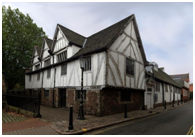
Leicester Guildhall. Wikipedia: attribution: NotFromUtrecht
Digging up History… (in spades)
Sufficient research has been done to suggest that the bones of Richard III probably did not end in the River Soar, but at some point, were removed to Greyfriars in Leicester and properly interred there. Thanks to some Tudors, Greyfriars has long since been pounded into the ground. An archaeological project, sponsored by the University of Leicester, and the City Council, among other supporters, has begun a dig. If they are correct about the evidence that there was a coffin containing the remains of the last Plantagenet king, discovery, and DNA testing will add to the historical record of England.
More than five hundred years since Richard III was brutally murdered by the party of the Lancastrian invader Henry (Tudor) VII, the question of Richard’s culpability in the apparent deaths of his pre-adolescent nephews, remains disputed. The last Plantagenet died at Bosworth, Leicestershire, August 22, 1485. August 22nd. Time for celebration of life.
Based on the portraits, who would you prefer?
Leicestershire and Richard Armitage
Although Mr. Armitage has grown (yes, grown. And grown (And grown…) to be a citizen of the world, as well as of London, the heart of England, no doubt, had been a good grounding site for an English actor. And Leicestershire is in the heart of England. Perhaps the heart of England. Perhaps Mr. Armitage will play the role of his namesake one day, in a realistic production of that tudorised king. For the numerous among our support group who are not overly fond of beards, they will be relieved to know that clean-shaven was the norm with the 15th C man….
And during this week, we wish Mr. Armitage :
MANY HAPPY RETURNS!
(He’s all grown-up, now. 😀 )


